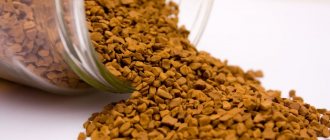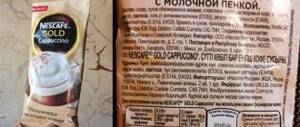When there is neither time, nor conditions, and sometimes even the desire to brew a cup or two of full-fledged natural coffee, bags labeled “three in one” are very helpful: they contain instant coffee, milk or cream, and sugar. At the very least, all these ingredients must be present. What is it really like? Let's figure it out. But first, a little background.
How was the 3-in-1 coffee drink created?
At the beginning of the last century, manufacturers implemented on an industrial scale a very sensible idea that allowed them to save time - they began to produce instant coffee. However, carrying a can of powder with you to work in a handbag, taking it on trips or outings, you will agree, is not entirely convenient.
Thus, in order to satisfy the needs of consumers, portioned coffee bags were developed. But this did not completely solve the problem - lovers of sweetened drinks also had to carry sugar with them. Therefore, the next step was to add it to a portion of instant coffee directly at the production site.
Now, however, fans of coffee with milk feel slighted. This means that it was quite logical to introduce powdered milk or cream into the contents of the bag. This is how three-in-one coffee, popular and in demand today, appeared.
What to do if you really want 3-in-1 coffee during pregnancy?
Doctors still advise not to be lazy, but to prepare yourself a similar drink, only from healthy ingredients: a little natural coffee, cream or milk, a little sugar. If you are worried about the dangers of caffeine, you can use chicory coffee, especially since it will taste quite similar to what is in the bag.
It is more logical to drink chicory coffee with milk and sugar during pregnancy, since from 3 to 1 you still won’t get caffeine, and you can choose a similar taste. That is, there is no point in consuming chemical powder from a bag.
If you really want 3 in 1, doctors allow you to pamper yourself no more than once a week. Or take 1-2 slow sips to enjoy the taste. Most people don't think the drink out of a sachet tastes that great, but pregnant women have some pretty weird preferences, so why not? It is better for the child if the mother is calm and happy with life than to be annoyed because she really wants a drink, but she can’t. Drinking a couple of sips once will not cause harm to the body, and chemical impurities will have time to be eliminated.
Chemical fats in artificial cream and large amounts of sugar cause some pregnant women to gain weight! If you have already gained a lot, you should give up this “pleasure” and still try to switch to a natural drink.
Be sure to drink 3 in 1 coffee with clean water to dilute the concentration of harmful substances and quickly remove them from the body through urine.
Composition of packaged coffee with cream: do we know what we are drinking?
Unfortunately, natural milk powder or cream has a limited shelf life. Therefore, to believe that such components are in sticks, the shelf life of which is measured in months, or even years, is at least naive. They are replaced with vegetable cream, which consists of:
- – coconut or palm oil;
- – milk protein;
- – glucose syrup;
- – acidity regulator;
- – emulsifiers, stabilizers, dyes, flavor enhancers.
As you can see, instead of natural cream, the packaged drink uses a component with a rather complex chemical composition.
Now – directly about coffee. It is the most expensive ingredient in the 3-in-1 mixture, so it is not surprising that manufacturers are trying to save money on this component. This means that the packaging may contain a small amount of low-grade coffee, as well as chicory, chopped nuts, chestnuts or barley grains. Such a marketing ploy does not harm the body, but such a drink has nothing to do with coffee, even if the packaging indicates the opposite.
As for sugar, everything is simple: the more there is, the more obvious the manufacturer’s attempt to mask the imperfect taste of coffee and cream looks. Therefore, instant drinks from three-in-one packages often have an overly sweet, even cloying taste.
The remaining additives - caramel, rum, cognac, nutmeg, coconut and others - also have a very indirect relationship to their natural ancestors.
Conclusions:
- Pregnant women should not drink 3 in 1 coffee, since it contains no more than 1% caffeine, a lot of sugar, and everything else is artificial chemical additives.
- With constant consumption of the contents of the sachets, carcinogens and substances that negatively affect the gastrointestinal tract, heart and blood vessels can accumulate in the body.
- It is best to replace it with a natural drink, perhaps from chicory, or add regular milk or cream.
- If you really want to, you can sometimes allow yourself a couple of sips of your favorite drink, or drink a cup of coffee from a bag once a week.
- Be sure to wash down your 3-in-1 coffee with plenty of still water.
Harm or benefit: is it worth drinking 3-in-1 coffee drinks?
Here, of course, you should focus on your well-being and listen to your own sense of proportion. You won’t find anything useful that is in natural coffee with fresh cream in “quick” sticks. Instant ersatz does not contain only caffeine - all other components are destroyed during long-term heat treatment of natural coffee. Vegetable cream powders are transgenic fats that negatively affect liver function and cardiovascular health. And an excess of sugar as a fast carbohydrate, although it saturates the body with energy almost instantly, in the long term it becomes the cause of the development of type 2 diabetes.
But it's not all that bad. In moderate quantities, none of the components of the 3-in-1 drink will harm your body. This means that sometimes you can treat yourself to quick, easy-to-prepare and, of course, pleasant-tasting creamy coffee. By the way, this mixture also makes amazingly delicious original desserts.
Why can't pregnant women have 3-in-1 coffee?
It is enough to study the inscription on the bag to understand the composition. And think about whether you really want to “please” yourself and your unborn child, whose organs and systems are just being formed. The composition of 3 in 1 coffee may vary slightly from one manufacturer to another, but in most cases it is approximately the same. The components are listed in the order they appear on the packaging, that is, from most to least.
1. Sugar . Usually comes first on the list, and precisely because there is the most sugar in the bag.
2. Cream substitute . None of the 3 in 1 coffee manufacturers in the mass market format put real dry cream in it, as this would lead to an increase in the price of the product. They use a whole complex of additives, which includes glucose syrup, palm oil, stabilizers E340, E331, E452, E451, milk protein caseinate, emulsifiers E471 and E472e, flavoring, anti-caking agent against lumps and salt.
- Glucose syrup is a vague name, since it can be made from anything, including potatoes or corn, but chemical options are also possible.
- Palm oil is a substitute for milk fat because oil is cheaper. This is a fairly strong carcinogen, which also increases cholesterol levels in the blood. By the way, oil is very difficult to remove from the body, since it does not melt (its melting temperature is 40 degrees, and in the human body it is usually up to 37). It clogs blood vessels and intestines, and can also lead to vascular thrombosis in a child.
- E340 is an acidity regulator, and formally it is approved for use in European countries, but studies have shown that it can cause intestinal disorders.
- E331 is sodium citrate, and it is, in principle, harmless, used as a dye.
- E452 and E451 are phosphates that can cause gastrointestinal diseases if consumed constantly.
- Sodium milk caseinate – can clog blood vessels and capillaries when large amounts accumulate in the body.
- E471 and E472e are stabilizers with a high fat content and can be harmful to the liver in large quantities.
- The flavoring agent and anti-caking agent E551 are harmless and are excreted from the body.
3. Coffee .
Yes, coffee comes in last place. Research conducted by independent experts has shown that the share of caffeine in 3 in 1 coffee on the domestic market is 0.28-0.3%. Less than one percent coffee per bag. And it also contains preservatives, flavors, dyes and everything else that is absorbed by the mother’s circulatory system and passed on to the unborn child. This can lead to future gastrointestinal diseases, weakness of the nervous system, and improper development of organs. 4. Cyclamate sweetener , if used, can theoretically lead to bladder cancer.
How to choose the right 3-in-1 coffee? Buying Tips
When you stop at a display case with coffee sticks, don’t rush to grab the cheapest one, don’t be fooled by the bright packaging and provocative inscriptions “Promotion! +20% free." Spend a few minutes looking closely at each variety.
- Inspect the packaging. It should be intact, not frayed, and the paint should not remain on your fingers.
- It is advisable to choose bags with notches - they are easier to open without the use of cutting devices.
- Classic sticks that open in the center when broken are also convenient.
- Pay attention to the composition: whether there is coffee among the ingredients, where it is placed (if it is in the last place, it means there is a minimum amount of coffee powder in the serving). Choose products with the least amount of additives - stabilizers, emulsifiers, dyes, sweeteners, flavor enhancers. The minimal amount of sugar is another plus of this drink.
How to choose 3 in 1 coffee?
Compare prices. If a bag of coffee costs much less than others of the same type, there is a reason to refuse the purchase. Coffee is the most expensive component of the mixture. A low price may mean that there is no coffee in the product.
Inspect the packaging. The bag must be neat, intact, without damage. If the paint wears off from the heat of your hands, then most likely you are looking at a counterfeit. If the packaging is even slightly damaged, it means that moisture from the air has already gotten inside. The powder could become damp, and this leads to its rapid deterioration.
Read what is written on the package. All inscriptions (including composition) must be printed in such letters that they are easy to read. If the font is unclear, the letters merge, it’s worth thinking: maybe the manufacturer has something to hide?
Study the composition. Coffee should be at the top of the list.
Evaluate ease of use. Conscientious manufacturers who care about customers make special notches on coffee bags. The bag itself is made of durable material to protect the product from moisture. It is very difficult to tear such packaging by hand. Do you always have scissors at hand? Using a notch, a bag of dry drink can be opened easily and quickly.
Try different brands. Even if all the previous conditions are met, the buyer may not like the taste. After all, each manufacturer prepares this drink according to its own recipe. The drink may seem too sweet, too bitter, even too strong. Therefore, it is worth buying several bags and choosing the right one among them: with a strong, persistent aroma, pleasant taste, warming, invigorating.
Articles about coffee / The effect of coffee on the human body 07/22/2016
When there is neither time, nor conditions, and sometimes even the desire to brew a cup or two of full-fledged natural coffee, bags labeled “three in one” are very helpful: they contain instant coffee, milk or cream, and sugar. At the very least, all these ingredients must be present. What is it really like? Let's figure it out. But first, a little background.
“3 in 1” coffee test: trying different brands and determining the leader
At one time, the television program “Test Purchase” conducted a fairly in-depth study of several well-known brands of this controversial drink. The brands participating in the experiment were Nescafé, Maxwell House, Coffee Club, Eagle Premium and Fes Aroma. The second and third samples were rejected by ordinary consumers at the tasting stage - they simply had neither the taste nor the smell of coffee.
The remaining three were sent to the laboratory for testing. At the same time, an artificial sweetener was discovered in the trendy Nescafe brand. But the much lesser-known Fes Aroma demonstrated not only a pleasant taste and aroma, but also pleased researchers with an impressive mass fraction of coffee in the composition.
You can be guided by this result, or you can conduct your own test by trying several varieties and choosing the one that is most suitable for you. After all, the most delicious, healthy, pleasant and invigorating coffee is the one that will give you the most pleasure!
Varieties of coffee 3 in 1
There are a large number of types of coffee bags on the market, which differ in both flavoring additives and components. Three groups of drinks can be distinguished:
- containing natural grains,
- created on the basis of chicory,
- drinks made from caffeine substitutes (acorns, chestnuts, cereals, etc.).
The most popular among manufacturers are:
- Nescafe;
- Jockey;
- Golden Eagle;
- Jacobs;
- Petrovskaya Sloboda.
Each brand offers consumers drinks with the addition of different flavor accents: cinnamon, nuts and even rum. So everyone can choose coffee to suit their taste and mood.
The Golden Eagle trademark is the first manufacturer to launch products on the Russian market. Its drinks vary in strength and the presence of flavoring additives. The low cost makes this brand popular, but when compared with other brands, Golden Eagle is very inferior in quality.
Three-in-one coffee from Jacobs has a richer taste and aroma, despite its softness. It is less sweet and more like natural coffee, and the latter is present in the composition. In addition to coffee drinks, Jacobs also produces instant tea bags. The packaged Vietnamese drink G7 can be considered the most natural and strongest - it will appeal to coffee lovers more than others. However, the high price makes it less popular among its analogues.











